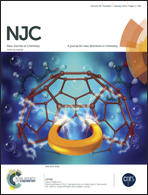Amperometric determination of promethazine in tablets using an electrochemically reduced graphene oxide modified electrode
Abstract
Graphene films were prepared on a glassy carbon electrode for amperometric determination of promethazine hydrochloride in pharmaceutical products. This modified sensor was prepared by chemical oxidation of graphite powder followed by product exfoliation in ultrapure water using an ultrasonic bath. Then, the resultant graphene oxide was electrochemically reduced in 0.10 mol L−1 acetic acid–sodium acetate (pH = 5.0) on a glassy carbon electrode surface. The proposed sensor exhibited reproducible amperometric responses in a wide linear range from 1.99 × 10−6 to 1.03 × 10−3 mol L−1 at +0.78 V (vs. Ag/AgCl). Low detection and quantification limits (1.99 × 10−7 mol L−1 and 6.63 × 10−7 mol L−1, respectively) were achieved. This method was applied to the analyses of commercial tablet samples and all results were in good agreement with those obtained using spectrophotometry and high-performance liquid chromatography.


 Please wait while we load your content...
Please wait while we load your content...